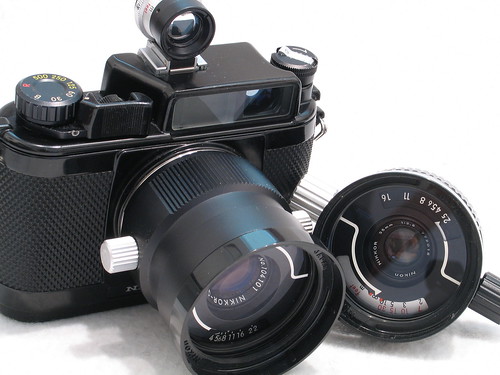Difference between revisions of "Nikonos III"
(above/below water lens note.) |
m (duh, it's in the photo) |
||
| Line 10: | Line 10: | ||
The '''Nikonos III''' underwater camera from [[Nikon]] succeeded the [[Nikonos II]] in 1975. This version added a bright-line viewfinder as well sprocket-gear frame spacing (which had been missing from prior Nikonos models). This would be the final model derived from the original French [[Calypso]] design inspired by Jacques-Yves Cousteau, although with a slight increase in body size. Its purely mechanical design gives it a reputation for robust reliability. | The '''Nikonos III''' underwater camera from [[Nikon]] succeeded the [[Nikonos II]] in 1975. This version added a bright-line viewfinder as well sprocket-gear frame spacing (which had been missing from prior Nikonos models). This would be the final model derived from the original French [[Calypso]] design inspired by Jacques-Yves Cousteau, although with a slight increase in body size. Its purely mechanical design gives it a reputation for robust reliability. | ||
| − | The standard lens is a Nikkor 35mm f/2.5 with [[zone focus|zone focusing]] and a useful [[depth of field]] scale. The version available alongside the Nikonos III has its | + | The standard lens is a Nikkor 35mm f/2.5 with [[zone focus|zone focusing]] and a useful [[depth of field]] scale. The version available alongside the Nikonos III has its aperture knob anodized black. Water's higher refractive index affects the behavior of optics: when submerged, the 35/2.5 yields a field of view equivalent to a ~47mm lens on land. The protective planar glass front of the f/2.5 lens permits its use both above and below the surface, which is not true of some of the more specialized underwater-Nikkor lenses. |
In 1980, Nikon would start from a "blank slate" and create its own original design, the [[Nikonos IV-A]] offering (battery-dependent) autoexposure. | In 1980, Nikon would start from a "blank slate" and create its own original design, the [[Nikonos IV-A]] offering (battery-dependent) autoexposure. | ||
Latest revision as of 17:49, 18 July 2015

|
| image by Andrea Buzzichelli (Image rights) |
The Nikonos III underwater camera from Nikon succeeded the Nikonos II in 1975. This version added a bright-line viewfinder as well sprocket-gear frame spacing (which had been missing from prior Nikonos models). This would be the final model derived from the original French Calypso design inspired by Jacques-Yves Cousteau, although with a slight increase in body size. Its purely mechanical design gives it a reputation for robust reliability.
The standard lens is a Nikkor 35mm f/2.5 with zone focusing and a useful depth of field scale. The version available alongside the Nikonos III has its aperture knob anodized black. Water's higher refractive index affects the behavior of optics: when submerged, the 35/2.5 yields a field of view equivalent to a ~47mm lens on land. The protective planar glass front of the f/2.5 lens permits its use both above and below the surface, which is not true of some of the more specialized underwater-Nikkor lenses.
In 1980, Nikon would start from a "blank slate" and create its own original design, the Nikonos IV-A offering (battery-dependent) autoexposure.
Links
- Evolution of Nikonos from Nikon.com
- Nikonos III manual (PDF) from Mike Butkus' OrphanCameras.com
- Nikonos III from Karen Nakamura's Photoethnography.com
- Nikonos III troubleshooting, by Bob Warkentin at Southern-Nikonos.com
- Nikonos I, II, & III from Photography in Malaysia

|
| With 80mm telephoto mounted image by Narsuitus (Image rights) |